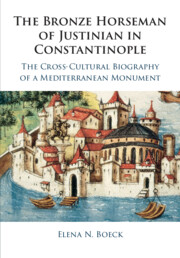 The Bronze Horseman of Justinian in Constantinople
The Bronze Horseman of Justinian in Constantinople Published online by Cambridge University Press: 08 April 2021
In the centuries after Justinian’s death, Constantinople’s bronze horseman became a defining presence on the city’s skyline. It signified imperial power and elicited competitive emulation. In the eighth–ninth centuries the lofty monument emerged as a powerful emblem in Byzantine–Abbasid relations. Abu Ja’far al-Mansur, the creator of Baghdad, placed a prominent equestrian statue atop the tallest, central dome of his new capital. This chapter discusses the so-called "crown of Baghdad," a forgotten sculptural monument which once mirrored Constantinople’s horseman in form and function. The dome and its sculpture immediately became iconic features of the city. They could be seen from the outskirts of Baghdad or even at a more distant approach to the city. The dome and its monument were calculated statements of imperial power that were deeply embedded in the Abbasid–Byzantine dialogue. I argue that this bronze, sculptural monument in the heart of Baghdad was created as a conscious and deliberate response to the bronze horseman of Constantinople. It grew in mythology, stature, and significance to rival the bronze horseman. By contextualizing the Baghdad monument within a competitive relationship, a forgotten facet of Abbasid–Byzantine cultural dialogue has emerged.
To save this book to your Kindle, first ensure [email protected] is added to your Approved Personal Document E-mail List under your Personal Document Settings on the Manage Your Content and Devices page of your Amazon account. Then enter the ‘name’ part of your Kindle email address below. Find out more about saving to your Kindle.
Note you can select to save to either the @free.kindle.com or @kindle.com variations. ‘@free.kindle.com’ emails are free but can only be saved to your device when it is connected to wi-fi. ‘@kindle.com’ emails can be delivered even when you are not connected to wi-fi, but note that service fees apply.
Find out more about the Kindle Personal Document Service.
To save content items to your account, please confirm that you agree to abide by our usage policies. If this is the first time you use this feature, you will be asked to authorise Cambridge Core to connect with your account. Find out more about saving content to Dropbox.
To save content items to your account, please confirm that you agree to abide by our usage policies. If this is the first time you use this feature, you will be asked to authorise Cambridge Core to connect with your account. Find out more about saving content to Google Drive.